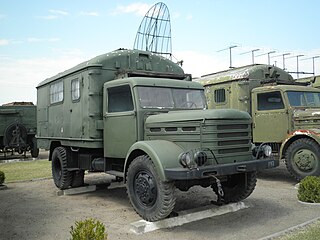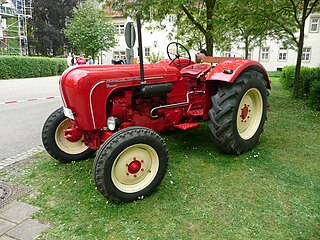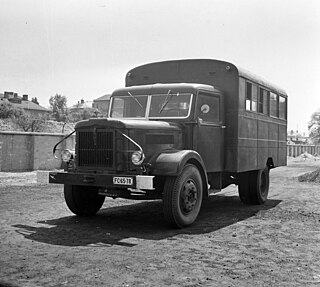
The Audi S4 is the high performance variant of Audi's compact executive car A4. The original Audi S4, built from 1991 until 1994, was a performance-oriented version of Audi's 100 saloon/sedan. All subsequent S4s since 1997 have been based on the Audi A4; and as the A4 has evolved from one generation to the next, so has the S4.

The Maruti Suzuki Gypsy is a four-wheel-drive vehicle based on the long wheelbase Suzuki Jimny SJ40/410 series. It was being built at the Maruti Suzuki's Gurgaon, India plant since 1985. It was primarily built as an off-road vehicle and all models were built with selectable 4WD. It was extremely popular with Indian Armed Forces and Police & Law enforcement in India. Official production came to an end in 2018 due to tightening emissions and crash standards. However, Maruti has not dismantled the production line and is still producing the Gypsy in batches specifically for the Indian Armed forces. Maruti is also committed to providing spares and service owing to significant number of vehicles still in service with the Armed Forces and Law Enforcement.

The Audi S6 is a high-performance variant of the Audi A6, an executive car produced by German automaker Audi. It went on sale in 1994, shortly after the "A6" designation was introduced, replacing the "100" nameplate.

Sisu K-44 is a three-axle 4×4+2 driven lorry made by the Finnish heavy vehicle manufacturer Suomen Autoteollisuus (SAT) from 1959 to 1965. The most usual applications were for log transportation and earth moving vehicles. The K-44 was noted for its excellent gradient capabilities. The legally permissible maximum vehicle payload was between 7 800 and 11 750 kg: with a trailer this increased to 20 000 kg. The K-44s were powered by Leyland diesel engines with power outputs of between 85.8 and 156.7 kW.

Ikarus 280 was an articulated bus produced by Hungarian bus manufacturer Ikarus from 1973 to 2002. It was succeeded by the Ikarus 435 in 1985.

The Ikarus 250 is a high-floor bus used as a coach for long-distance service. It was made from 1968–1989, alongside the smaller Ikarus 256, by the Hungarian bus manufacturer Ikarus.

The Ikarus 256 is a high-floor bus used as a coach for long-distance service and for interurban traffic. It was made from 1977–1989, alongside the larger Ikarus 250, by the Hungarian bus manufacturer Ikarus.

The IFA Horch H3, also known as IFA H3, is a short bonnet lorry, and the first series production vehicle by East German VEB HORCH Kraftfahrzeug- und Motorenwerke Zwickau, later known as VEB Sachsenring Automobilwerke Zwickau. The short-lived H3 was produced from 1947 to 1949 in Zwickau ; 852 were produced. Several parts used in the H3, most notably the engine, were originally intended to be used for Sd.Kfz. 11 half tracks.

The IFA H6 is a 6.5 tonne lorry, made by East German manufacturer VEB Kraftfahrzeugwerk »Ernst Grube« Werdau. It was available in long wheelbase lorry (H6), and short wheelbase tractor (H6Z) versions. Approximately 7,500 were built from 1952 to 1959. The bus IFA H6B was based upon IFA H6 components. For political reasons, there were no successors to the H6. Such had been developed, but production of the smaller IFA S 4000-1 commenced at IFA's Werdau plant instead.

The IFA Horch H3A, later known as just the IFA H3A, is a 3 tonne lorry, made by East German manufacturer VEB HORCH Kraftfahrzeug- und Motorenwerke Zwickau. It was presented as a flatbed lorry at the Leipzig Trade Fair in early 1949, and officially offered for sale from mid 1950. The H3A tractor followed in 1951. In total, 180 IFA H3A chassis were used for manufacturing the IFA H3B bus in 1952 and 1953. The IFA H3S succeeded the H3A in 1957.

The Csepel D-344 is a medium size, 3-tonne, 4×4 off-road lorry, made by Hungarian manufacturer Csepel Autógyár, from 1961 to 1975. It was first presented to the public on the Leipzig Trade Fair in early 1963. The Hungarian People's Army purchased huge quantities of the D-344, and eventually used it as their standard lorry. It proved to be robust and reliable.

The MAN 630 is a five-tonne lorry, made by German manufacturer Maschinenfabrik Augsburg Nürnberg, from 1953 until 1972. It was made in three major variants, the civilian L1, the military L2, and the civilian L3, with L being an abbreviation for the German word for Lorry, Lastkraftwagen. The military L2 versions were by far the most common MAN 630s. The German Bundeswehr purchased approximately 30,000 units of the L2, and used it as their standard lorry alongside the similar five-tonne Mercedes-Benz LG 315.

The Barkas V 901/2 is a light commercial lorry made by the East-German manufacturer VEB Barkas-Werke, Hainichen in Karl-Marx-Stadt (Chemnitz) from 1954 until 1961. Originally, the vehicle was called the IFA V 901/2; this name was changed to Barkas V 901/2 in 1957. The V 901/2 is a body-on-frame vehicle with a front engine, and rear-wheel drive, that was available in several different body styles, including pickup trucks, minibusses, and panel vans. It succeeded the IFA Framo V 901, and was itself succeeded by the Barkas B 1000.

The Porsche-Diesel 419 is an agricultural tractor made by Porsche-Diesel Motorenbau, and part of Porsche's Master series. It was the biggest and most powerful series-production tractor ever sold under the Porsche brand. In total, 1175 units were produced from 1960 until 1963. The 419 was preceded by the 418, and had no successor, since Porsche-Diesel Motorenbau stopped producing tractors in 1963. That same year, the catalogue price for a Porsche-Diesel 419 was DM 15,290.
Texmaco Perkasa is a family of medium-duty commercial vehicles manufactured by Indonesian automaker PT Wahana Perkasa Auto Jaya, which is a company under the Texmaco group. Started production after the New Order in 1999 by making trucks, and in 2001 finally participated in producing variants of bus vehicles. Perkasa means "mighty" in Indonesian. These vehicles are well known in Indonesia for being the standard trucks and buses operated by the Indonesian Armed Forces. Perkasa truck was first launched in late 1998, with a claim of 90% local content. TNI and Polri are the first customers, intended as military vehicles and tactical vehicles. Perkasa stopped production in 2004 after the Texmaco group went bankrupt by IBRA.

The Trabant P 50, also known as the Trabant 500, is the first series production model of the East German Trabant series, produced by VEB Sachsenring Automobilwerke Zwickau from 1957 until 1962. In total, 131,495 units were built. In 1962, VEB Sachsenring switched production from the P 50 to the short-lived intermediate model Trabant 600, which combined the exterior styling of the Trabant P 50 with the technical design of the next generation Trabant model, the Trabant 601.

The Trabant 600, also known as the Trabant P 60, is the second series production model of the East German Trabant series, produced by VEB Sachsenring Automobilwerke Zwickau from 1962 until 1965. In total, 106,117 units were built. The Trabant 600 was a short-lived intermediate model that combined the exterior styling of the Trabant P 50 with the technical design of the next generation Trabant model, the Trabant 601. For a short period of time, the Trabant 600 estate was built alongside the 601 saloon.

The Robur LO 3000 is a 3-ton lorry made by the East German industrial vehicle manufacturer VEB Robur-Werke Zittau from 1973 until 1984. The vehicle was sold under IFA's Robur brand. It is the civilian rear-wheel drive Robur model of its time, and was produced alongside the all-wheel drive Robur LO 2002 A model. The LO 3000 is powered by an air-cooled Otto (petrol) engine; a dieselised version of the LO 3000, called the LD 3000, was made from 1982 until 1984, albeit in small numbers. As with its predecessors, the LO 3000 was made in several different versions. The VEB made the vehicle with two different wheelbase options, and offered more than twenty different body styles, including a bus version.

The Wesseler W 17 is an agricultural tractor made by H. Wesseler OHG. It is the firm's smallest two-cylinder model and was made from 1954 until 1956. In the Netherlands, the tractor was sold under the Vewema brand.

The Csepel D-350 is a lorry made by Hungarian manufacturer Csepel Autógyár from 1950 until 1958. It was the first series production Csepel vehicle, and a copy of the Austrian Steyr 380 lorry, built under licence.




















